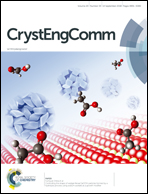Rational assembly of functional Co-MOFs via a mixed-ligand strategy: synthesis, structure, topological variation, photodegradation properties and dye adsorption†
Abstract
Four novel Co(II) metal–organic frameworks, namely [Co2(4,4′-cpmb)2(1,1′-bbi)2]n (1), [Co(4,4′-cpmb)(4,4′-bbibp)]n (2), {[Co(4,4′-cpmb)(tib)]·3(H2O)}n (3) and {[Co(4,4′-sdc)(tib)]·(H2O)}n (4) (flexible 4,4′-cpmb = 4-(4-carboxylphenylmethylthio)benzoic acid, rigid 4,4′-sdc = 4,4′-stilbenedicarboxylic acid, flexible 1,1′-bbi = 1,1′-(1,4-butanediyl)bis(imidazole), rigid 4,4′-bbibp = 4,4′-bis(benzoimidazo-1-ly)biphenyl and rigid tib = 1,3,5-tris(1-imidazolyl)benzene) were synthesized employing a rational design approach under solvothermal conditions and further characterized by elemental analysis, IR spectra, thermogravimetric (TG) analysis, powder X-ray diffraction (PXRD), and single-crystal X-ray diffraction. The four Co-MOFs display different interpenetrated structures due to the flexibility of O/N-donor ligands. Single-crystal X-ray diffraction analysis reveals that complex 1 displays a 6-fold interpenetrating class Ia net with the point Schläfli symbol of (66). Complex 2 shows a 3-fold interpenetrating sqc5 net with the point Schläfli symbol of (66·8). Complexes 3 and 4 exhibit a 2-fold interpenetrating 4-connected sql topology with the point Schläfli symbol of (44·62). The photodegradation properties and dye adsorption capacity of complexes 1–4 are investigated, and the framework integrity of complexes 1–4 can be well-retained.



 Please wait while we load your content...
Please wait while we load your content...